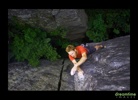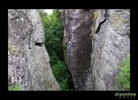Okay, this is pretty rad. We stayed at a friend of a friend’s house in Wanaka for about a week, and part way through our visit, Ben decided to let us in on a little secret.
Way up on a hill above a river he’d discovered a huge crag that he was trying to develop. The Wanaka Rock Climbing Club has a battery-powered rotary hammer drill that anyone can borrow, so he’d been going up there bolting new sport climbs. One day while he was walking around and scoping his new crag, he found a giant hole in the ground — a hole 100 feet deep, 15 feet wide and maybe 40 feet long. The dimensions at the top of it are the same as the dimensions at the bottom, and the walls are completely sheer. It probably was formed by a giant earthquake. It’s a crazy fractured chasm; one side is completely overhung and the other is a blank slab. In the middle is a sharp, aesthetic arete that looks completely unclimbable from above.
So Ben took us to this hole and we were astounded. We stared awestruck at the arete wondering if it would go. We figured it was possible, but damn hard. Maybe 5.14 or so. There didn’t seem to be any holds, but we had to take a closer look. Since we couldn’t figure out how to get to the bottom of pit, we installed a rappel anchor on the side of it and threw a rope down, eyeballing and cleaning an easy line adjacent to the arete. Since the hole is so deep, steep and narrow, we actually couldn’t even see the bottom. I rapped in first and wondered if I was the first human ever to set foot down there. As I descended, I encountered walls carpeted with mosses, ferns, lichens and molds. It was nuts. The bottom was dank, wet and really green, and it was blanketed in a 2-foot-deep layer of peat. Waaaaaaaayyy cool. I eyeballed that arete, and to my surprise there actually were holds. Maybe that line could go. Maybe. But I still figured it would be at least 5.13. Hmm.
Next we put a few bolts on the top of the arete and rappelled down that with hammers and a brush. We scrubbed off lichens on the key holds and broke all the chossy bits off. Each time a smacked off a jib or crimper, an unfortunate feeling in my stomach grew. This line is amazing, I kept thinking, but way too hard. Nevertheless, we decided to give it a go on toprope. And guess what?! It went! We played around on it for an hour, figuring out the moves and discovering the arete’s intricacies. It’s super technical, sustained, overhanging. Half way up the climber swings off the arete onto a thin, balancy face, and then then finishes again on the arete. I’ve only seen one arete as clean and sharp as this one in my life. The more we played on it, the more we realized it was climbable. So we bolted it and came back a week later with a bunch of friends for a first, second, third, fourth and fifth ascent.
Here’s the description, to be printed in the next edition of the Wanaka climbing guidebook:
Freeloader, 5.12b/c, 7 bolts. Hyper classic! Sustained climbing on a striking overhung arete to hard cranking on a subtle, crimpy face. Described by the third, fourth and fifth ascentionists as “the best route in Wanaka,” “the best sport climb in New Zealand,” and “the best, most sustained arete I’ve ever climbed anywhere.” Rap into a double bolt belay 30′ from the bottom of the hole, pull through a traverse and charge up the arete’s slopers and crimps, all the while teetering over the 100-foot-deep abyss. Equipped/First Ascent by Nathan Welton and Pierre Boissier, March 2007.
So named because we stayed at Ben’s house for way too long, borrowed someone else’s drill, and had to borrow shoes and chalk to make the first ascent. Shameless.
Sorry to brag about this thing. It’s just way too cool. I’m so psyched! Sometimes you get jazzed about a climb you’ve developed simply because it’s “your baby.” But this thing really is something else. I’ve never seen such a rock formation in my life.
Here are some images — that first one of me was shot by my buddy Pierre, who is in the second picture.





